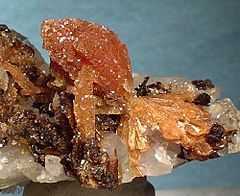Hubeite
| Hubeite | |
|---|---|
|
Hubeite cluster in Apophyllite | |
| General | |
| Category | Sorosilicate of the [Si4O13] group, Akatoreite group |
| Formula (repeating unit) | Ca2Mn2+Fe3+ [Si4O12(OH)] (H2O)2 |
| Crystal symmetry | P1* Space Group |
| Identification | |
| Color | Dark to pale brown |
| Crystal habit | Aggregates of inter-grown crystals |
| Crystal system | Triclinc |
| Cleavage | 1 good cleavage parallel to c-axis |
| Fracture | Conchoidal fracture |
| Tenacity | Brittle |
| Mohs scale hardness | 5.5 |
| Luster | Vitreous |
| Streak | Orange-brown |
| Density | 3.02g/cm3 |
| Birefringence | 0.023 (γ-α) |
| Pleochroism | Yes |
| 2V angle | 87(5)o and 89(2)o |
| Ultraviolet fluorescence | None |
| References | [1] |
In geology, the mineral hubeite, Ca
2Mn2+
Fe3+
[Si
4O
12(OH)] (H
2O)
2, is a sorosilicate of the Si
4O
13 group. Structurally it also belongs to the Akatoreite group. It was found and named after the province of Hubei, China. It is common to iron ores in a mine of that region. Occurs mainly as aggregates of fan like crystals that intergrown. It is dark to pale brown, has orange-brown streak and is vitreous. Hubeite has a hardness of 5.5 in the Mohs scale, one good cleavage and conchoidal fracture. It is triclinic with a space group of P1*. The structure of hubeite is very uncommon, and in fact there is only one other mineral that fits the Si
4O
13 group, which is ruizite.
Background
Hubeite, Ca2Mn2+Fe3+ [Si4O12(OH)] (H2O)2, was discovered by Hawthorne et al. (2002) at the Daye mines in the Hubei province of China. It is classified as a sorosilicate, based on its formula (Hawthorn et al., 2004). Other related minerals would be inesite, Ca2Mn2+7 (OH)2 [Si4O12] (H2O)5 (Hawthorne et al., 2004), ruizite Ca2Mn2 [Si4O11(OH)2](OH)2(H2O)2 (Hawthorne et al., 2002) and Akatoreite Mn9Al2Si8O24(OH)8 (Burns et al., 1993).
Composition
To analyze the composition, an electron microprobe was used in the wavelength-dispersion mode (Hawthorn et al., 2002). The main idea was to come up with a chemical composition in weight percent. The quantity of (OH) and (H2O) was acquired by solid solution and refinement, based on previous work by Hawthorne et al., 1990. To assure the presence of (OH) and (H2O) groups, an infrared spectrum was also recorded (Hawthorn et al., 2002).
Physical and optical properties
Hubeite is most common as aggregates of intergrown crystals (Fig.1) that are usually less than 5mm across and that have individual crystals with well-developed faces that are as long as 1mm (Hawthorne et al., 2002). The color ranges from pale to dark brown, depending on the crystal size (Fig.2). Other properties consist of a pale orange-brown streak, vitreous luster, non-fluorescence, and 1 good cleavage parallel to c-axis. It is also brittle with conchoidal fracture, has a hardness of 5.5 in the Mohs scale and a density of 3.02g/cm3 (Hawthorn et al., 2002). As for optical features, it is important to note that hubeite is strongly pleochroic, biaxial with an indeterminate optic sign and has a birefringence of 0.023 (γ-α) (Hawthorne et al., 2002).
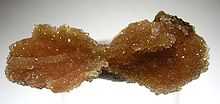
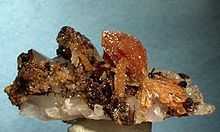
Structure
The crystals used for structure study were acquired at the Daye Mine (Hawthorne et al., 2004). To get a first general idea of the mineral structure it went through X-ray intensity data analysis and then, for a more detailed study, an electron microprobe was used (Hawthorne et al., 2004). Hubeite is triclinic (P1*). Basically, there are two Ca sites in the structure of hubeite, with site one being and octahedron and the second site is coordinated by 6 oxygen atoms at the same distance and one extra oxygen atom further out and arranged in an augmented octahedron (Hawthorne et al., 2004). There are also 4 sites for Si in tetrahedral arrangement, and the fourth site bonds to an OH group forming an acid-silicate group (SiO3(OH)) (Hawthorne et al., 2004). There are 2 oxygen sites that connect 2 Si atoms, thus creating a sorosilicate (Hawthorne et al., 2002). [Si4O13] corresponds to a four membered chain fragment of tetrahedra according to Hawthorne et al. (2004). The only other sorosilicate mineral that has that same four membered configuration is ruizite (Moore et al., 1985). The main difference of the two minerals is the valence of Mn and the existence of Fe3+ for Hubeite (Hawthorne et al., 2002). Ruizite is of the [Si4O13] sorosilicate group (Hawthorne, 1984) and when it was discovered, it did not much any other Ca-Mn silicate already known (Willams et al., 1977), and now with the discovery of hubeite it is easier to understand the [Si4O13] sorosilicate group. The other two sites left in the hubeite structure are filled with Fe with CN=6 and Mn with CN=6, being one of the bonds to OH in the Mn case. The structure of hubeite is heteropolyhedra, with alternating layers of tetrahedra and different polyhedra parallel to (001) (Hawthorne et al., 2004). The tetrahedral layers are formed by [Si4O13] sharing corners, and the other alternating layer is formed by the [6], [7] and [8] Ca, Mn+2 and Fe+3 polyhedral sharing edges (Hawthorne et al., 2004). This last feature is what relates hubeite to the Akatoreite group. Akatoreite, like hubeite, is triclinic with space group P1*(Burns et al., 1993). Akatoreite’ structure is layerd as well with alternating sheets of octahedra and tetrahedra, parallel to (101) (Burns et al., 1993). The octahedra groups, as well as one Mn tetrahedra group, are sharing edges and linked by the corner sharing tetrahedral. The same happens in ruizite, except that they are linked by the [Si4O13] group. The inesite structure also relates very well to the hubeite structure. It is also based on layers of edge sharing polyhedra alternating with corner sharing tetrahedra (Hawthrone et al., 2004). The main difference is that inesite is a cyclosilicate, and in fact, by omitting 2 of the 6 tetrahedra that form the tetraheda ring, and if the other 8 membered ring is broken and hydoxylated, the new arrangement becomes a hubeite (Hawthorne et al., 2004). This just confirms the association of hubeite and inesite in the Daye mines (Hawthorn et al., 2004).
Geological occurrence
Hubeite is mainly associated to a skarn assemblage with pink inesite, colorless apophyllite KCa4(Si4O10)2F*8(H2O), quartz SiO2, pyrite FeS2 and colorless-white calcite CaCO3 (Hawthorne et al., 2004). They all happen together at the Daye Mine. Usually hubeite appears in two different situations. It may happen as isolated aggregates of crystals perched on white quartz, or it may happen covering both sides of thick specimens, that are usually pink inesite and apophyllite (Hawthorne et al., 2002). Figures 3 and 4 illustrate both situations.
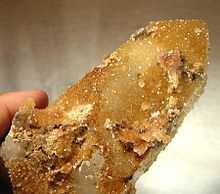
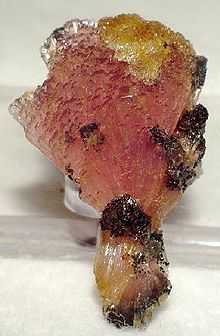
The localities where ruizite is found, associate it with apophyllite, inesite and pyrite as well, and there is no hubeite, which leads the conclusion that hubeite needs oxidized environments and sufficient concentration of Fe to occur. The Daye mine is an iron ore deposit (Dingyu et al., 1982). This specific area is characterized by deposits of late Paleozoic carbonate rocks in contact with plutons aging between the middle Jurassic to middle Cretaceous (Dingyu et al., 1982). According to Dingyu et al. (1982), the iron rich magma injections are the main cause for the formation of the ore deposits of the region. These polymetallic deposits, more than 200, form a belt that crosses China in the west-east direction (Ottens, 2007). Curiously, the mine where Hubeite was first found is in fact a wollastonite CaSiO3 source for minerals collectors.
Where in the world
Hawthorne et al. (2002) discovered hubeite in the Daye mine, in the Hubei province of China. This mine became very famous after that discovery and despite this specific breakthrough, the mine is most popular for its beautiful crystals of inesite and wollastonite (Ottens, 2007). It opened up in 1966 for copper exploration, but after the lack of profits, it became a major source for wollastonite (Ottens, 2007). Luckily, along the area of the Daye mine, there are other skarn-type Fe and Cu deposits that are big contributors to the overall China’s reserves of copper and iron (Ottens, 2007). Daye County is also rich in non-metallic mineral deposits, but it is the metallic ores that make it special and it is an important city for the manufacture of bronze (Ottens, 2007). The Hubei province has gold and silver production as the main revenue source (Ottens, 2007). This province is also one of the birthplaces of the Chinese bronze-age culture, represented in the artwork of the Yangtze River culture (Ottens, 2007). The copper extraction began in this area is related to the Yin Dynasty and the iron extraction began in the Qing Dynasty, making these mines a “symbol” in the Chinese culture (Ottens, 2007).
Literature survey
The most cited paper for this mineral is “Hubeite, a new mineral from the Daye Mine near Huangshi, Hubei Province, China” (Hawthorne et al., 2002). There are only two papers that extensively talk about Hubeite, and this was the first one to be published, and therefore is the most used one. Another important paper is “The crystal structure of Hubeite, a novel sorosilicate mineral” by Hawthorne et al. (2004). The other sources used for this paper were chosen according to the location that Hubeite was found and the related minerals, in structure and occurrence. Since the paper written by Hawthorne et al. (2002), China has seen a considerable increase in the interest for their mineralogy, in specific by collectors.
Prospects for further studies
One interesting fact about Hubeite is that it is biaxial with an indeterminate optic sign because of its 2V being close to 90o (Hawthorne et al. 2002). The main structural study done on this mineral was done more than 10 years ago by Hawthorne et al. (2004) and maybe there is a way now to try to find the optic sign, seeing that the value calculated and measured for 2V is not exactly 90o, but rather 87(5)o and 89(2)o respectively.
Special features and curious facts
The main characteristic of hubeite, and what distinguishes form any other mineral, is the four membered configuration of the tetrahedral, forming the group [Si4O13]. Seeing that ruizite also has the same group, hubeite differentiates on the content of Fe. Another special features is the bow-tie structure that the aggregate of crystals forms (refer to Fig 1). As mentioned before, this mineral was named after the province of Hubei, China, where it was found. Considering the name of the province being Hubei and the general ending for mineral names “-ite”, the name of the minerals should have been “hubeiite” instead of hubeite, according to (Ottens, 2007). Another curious fact related to names, is the fact that the name of the mine where Hawthorne et al. (2002) states that he found the mineral is sort of misleading (Ottens, 2007). The mineral is natural from the Fengjiashan wollastonite mine, also called by Daye copper mine, and there is another mine called Daye iron mine, where no Hubeite has been found (Ottens, 2007). It is easy to see where it can be misleading. Since Hawthorne et al. (2002) does not focus at all on the locality of the new found mineral, when the first paper that talks about the mineral was published, there were some supposed specimens in the market provided by Chinese minerals dealers. Those specimens would then be sold to American and European dealers. The problem is that from 2001 up until 2007, at least, there were no visits to the Fengjiashan mine by any other professional mineralogist or serious mineral dealers, and thus the specimen that was out in the market was actually manganbabingtonite, Ca2(Mn,Fe)FeSi5O14 (Ottens, 2007). One last curious fact involves the main attraction to the Fengjiashan mines, which is not Hubeite, but rather crystals of wollastonite and specially inesite. Inesite crystals are very beautiful and top wanted for collectors and, in the case of the Fengjiashan mines, it happens that most of the time these crystals are encrusted by hubeite crystals that make the first specimen much less attractive (Ottens, 2007).
References
- ↑ Hawthorne F C, Cooper M A, Grice J D, Roberts A C, Cook W R, Lauf R J (2002) Hubeite, a new mineral from the Daye mine near Huangshi, Hubei Province, China, The Mineralogical Record, 33, 465-471.
- Burns P C, Hawthorne F C (1993) Edge-Sharing Mn2+O4 tetrahedra in the structure of Akatoreite, Mn9Al2Si8O24(OH)8, The Canadian Mineralogist, 31, 321-329.
- Hawthorne F C, Cooper M A, Grice J D, Roberts A C, Cook W R, Lauf R J (2002) Hubeite, a new mineral from the Daye mine near Huangshi, Hubei Province, China, The Mineralogical Record, 33, 465-471.
- Hawthorne F C, Cooper M A (2004) The crystal structure of hubeite, a novel sorosilicate mineral, The Canadian Mineralogist, 42, 825-834.
- Hawthorne F C, Grice J D (1990) Crystal-structure analysis as a chemical analytical method: application to light elements, The Canadian Mineralogist, 28, 693-702.
- Moore P B, Shen J, Araki T (1985) Crystal chemistry of the [M*φ2(TO4)2] sheet: structural principals and crystal structures of ruizite, macfallite and orientite, The American Mineralogist, 70, 171-181.
- Ottens B (2007) The Fengjiashan Mine; Daye District, Ezhou Prefecture, Hubei Province, China. Mineralogical Record, 38(1), 33-42.
